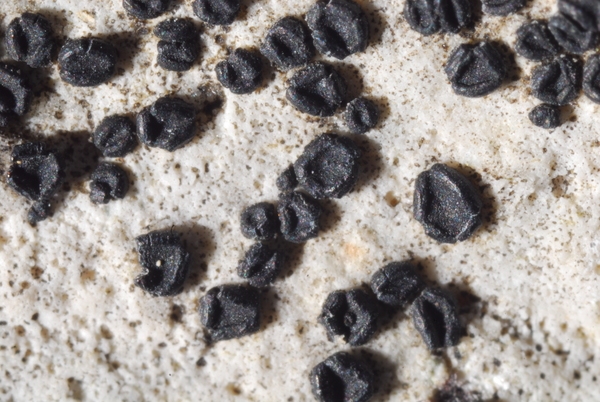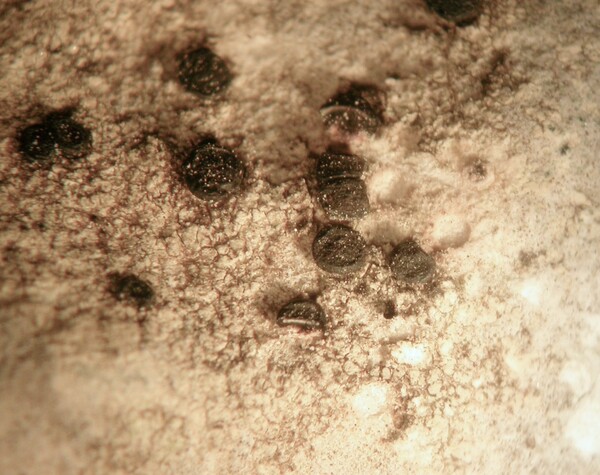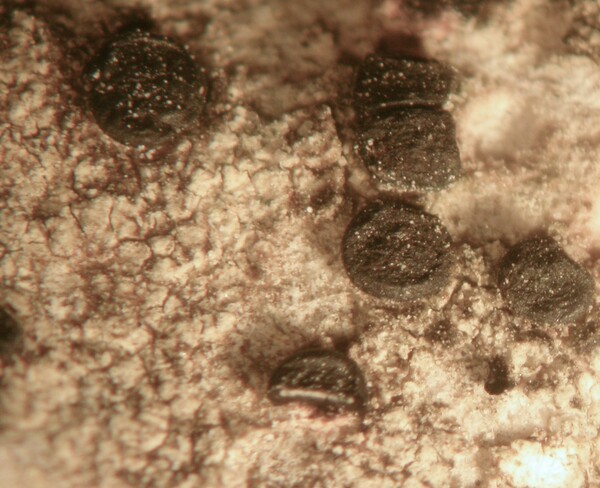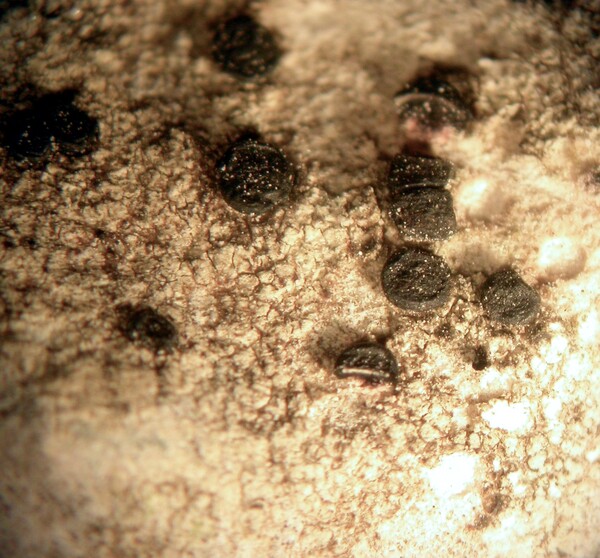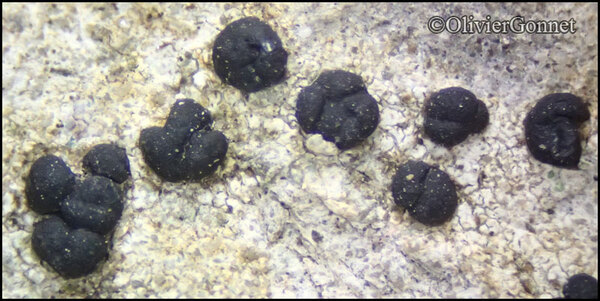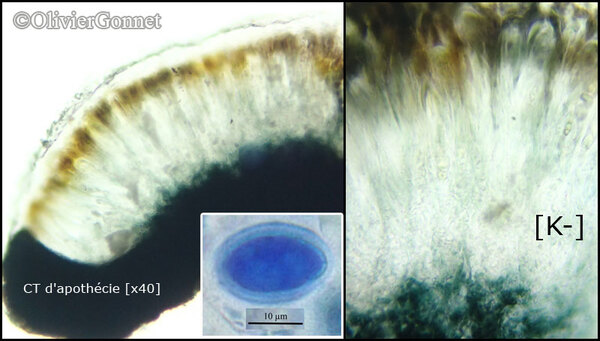Farnoldia jurana (Schaer.) Hertel subsp. jurana
Mitt. bot. Staatss. München, 19: 443, 1983. Basionym: Lecidea jurana Schaer. - Enum. Crit. Lich. Eur.: 123, 1850.
Synonyms: Biatora annularis Müll. Arg.; Biatora jurana (Schaer.) Hepp nomen sed non planta; Haplocarpon juranum (Schaer.) M. Choisy; Lecidea albosuffusa f. aggregata (Jatta) Zahlbr.; Lecidea albosuffusa Th. Fr.; Lecidea annularis (Müll. Arg.) Müll. Arg.; Lecidea caerulea Kremp.; Lecidea calcigena Flörke; Lecidea cyaniza Nyl.; Lecidea inferior Nyl.; Lecidea jurana f. dispersa Arnold; Lecidea petrosa Arnold; Lecidea petrosa f. aggregata Jatta; Lecidea petrosa var. glaucocarpa Arnold; Lecidea reuteri Müll. Arg.; Lecidea subvorticosa Nyl.; Melanolecia jurana (Schaer.) Hertel; Tremolecia jurana (Schaer.) Hertel
Description: Thallus crustose, endosubstratic or thinly episubstratic (to 0.3 mm thick), continuous to finely areolate, white to yellowish-ochre, sometimes (especially in high-altitude endolithic forms) with a pale blue tinge. Medulla white, I- or I+ pale blue. Apothecia lecideine, adnate and constricted at base, black, epruinose and somehow shiny or finely bluish-pruinose, (0.2-)0.5-1.5(-2.5) mm across, with a flat to finally convex, sometimes indistinctly umbonate disc, and a thick, usually persistent, often wavy proper margin. Proper exciple c. 60 µm wide, black, the hyphae 5-9 µm thick, K-; epithecium blue-green or greenish brown (the two colours often present in the same apothecium), 12-25 µm high, K-, often with a layer of crystals; hymenium colourless or greenish in upper part, 65-130 µm high; paraphyses coherent, branched and anastomosing, 1.7-2.2 µm thick at mid-level, the apical cells to 3 µm wide; hypothecium green- to brown-black, the upper part more intensive green, K- or K+ reddish brown, c. as high as the hymenium. Asci 8-spored, clavate, with a I+ pale blue tholus and a central amyloid tube, approaching the Porpidia-type. Ascospores 1-celled, hyaline, ellipsoid, 11-28(-33) x 6-15(-20) µm, halonate, the perispore to 3 µm thick. Pycnidia black, immersed, globose. Conidia bacilliform, 3.5-9 µm long. Photobiont chlorococcoid. Spot tests: thallus K-, C-, KC-, P-, UV-. Chemistry: without lichen substances.
Growth form: Crustose endolithic
Substrata: rocks
Photobiont: green algae other than Trentepohlia
Reproductive strategy: mainly sexual
Commonnes-rarity: (info)
Alpine belt: very common
Subalpine belt: extremely common
Montane belt: rather rare
Dry submediterranean belt: absent
Humid submediterranean belt: absent
Padanian area: absent
pH of the substrata:
1 2 3 4 5
Solar irradiation:
1 2 3 4 5
Aridity:
1 2 3 4 5
Eutrophication:
1 2 3 4 5
Poleotolerance:
0 1 2 3
Altitudinal distribution:
1 2 3 4 5 6
Rarity
absent
extremely rare
very rare
rare
rather rare
rather common
common
very common
extremely common
Loading data...
Occurrence data
Predictive map
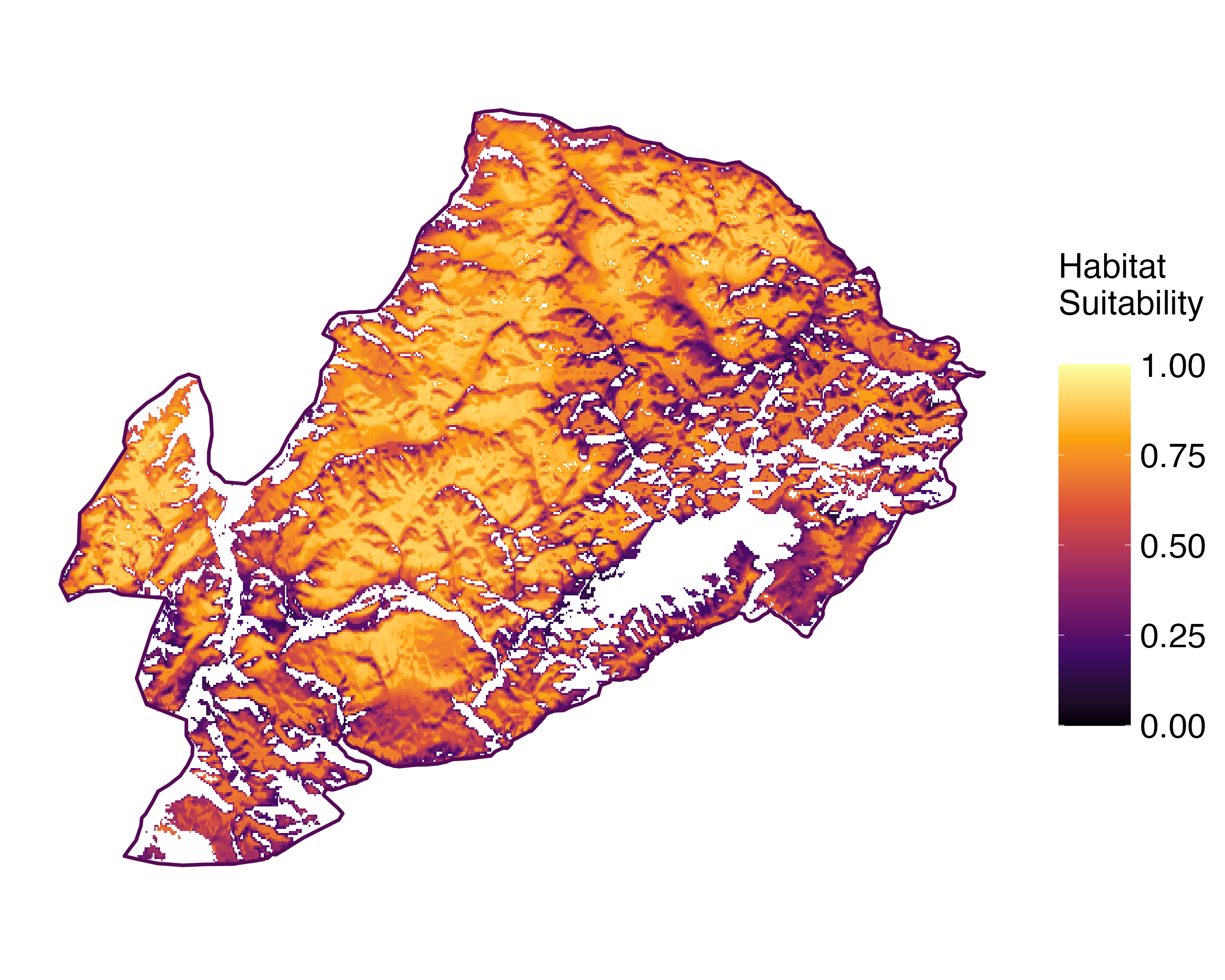 Current prediction (1981-2010)
Current prediction (1981-2010) Future prediction (2071-2100) SSP 1-2.6
Future prediction (2071-2100) SSP 1-2.6 Future prediction (2071-2100) SSP 5-8.5Predictive maps according to Francesconi et al. 2025
Future prediction (2071-2100) SSP 5-8.5Predictive maps according to Francesconi et al. 2025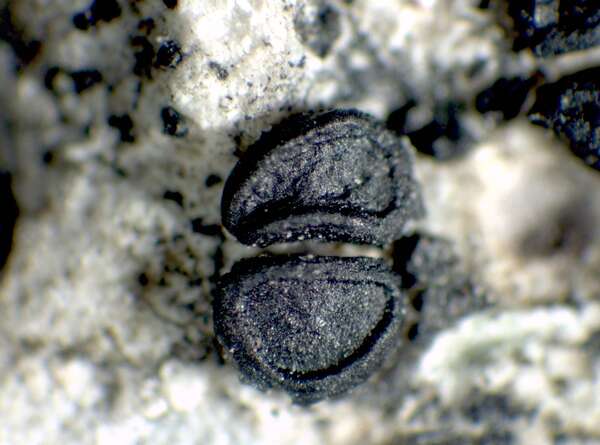
P.L. Nimis; Owner: Department of Life Sciences, University of Trieste
Herbarium: TSB (10641)
2001/11/24
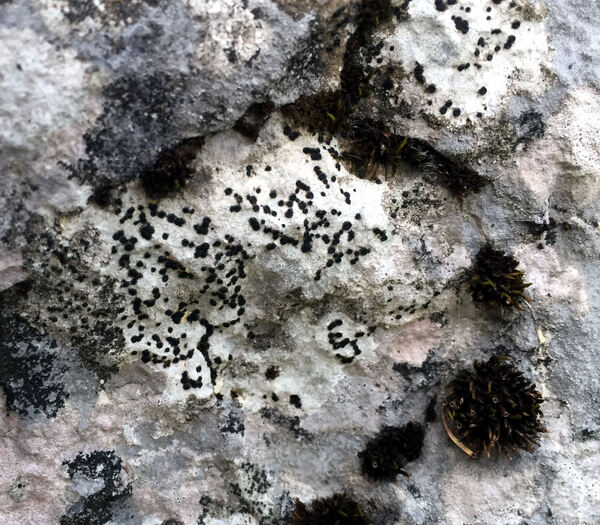
P.L. Nimis; Owner: Department of Life Sciences, University of Trieste
Italy, Friuli Venezia Giulia, Udine, Passo del Pura, Ampezzo Carnico, 1400 m
09.09.2016
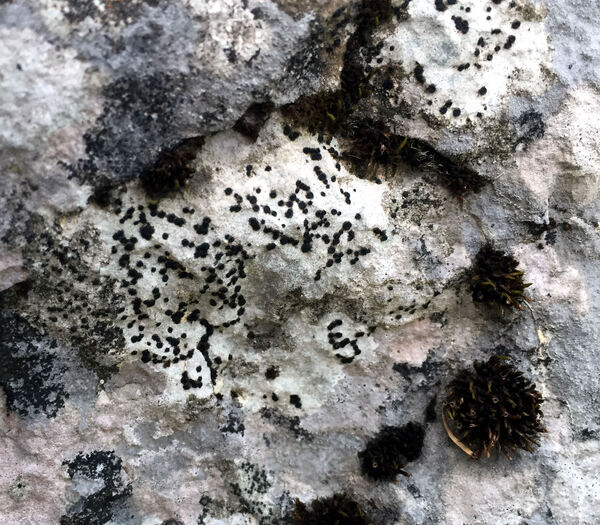
P.L. Nimis; Owner: Department of Life Sciences, University of Trieste
Italy, Friuli Venezia Giulia, Udine, Passo del Pura, Ampezzo Carnico, 1400 m
09.09.2016
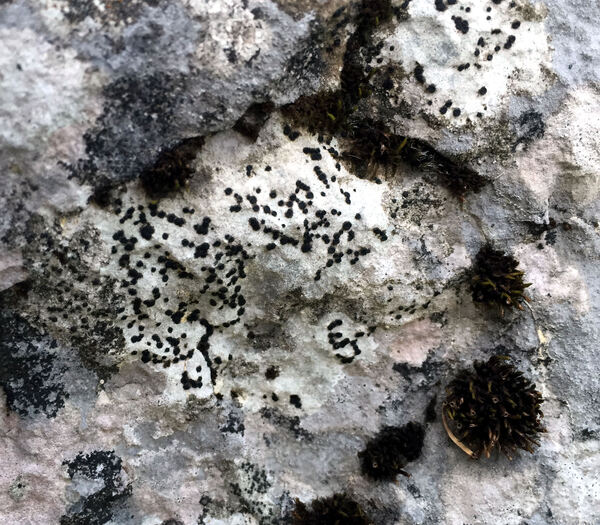
P.L. Nimis; Owner: Department of Life Sciences, University of Trieste
Italy, Friuli Venezia Giulia, Udine, Ampezzo Carnico, 650 m
09.09.2016
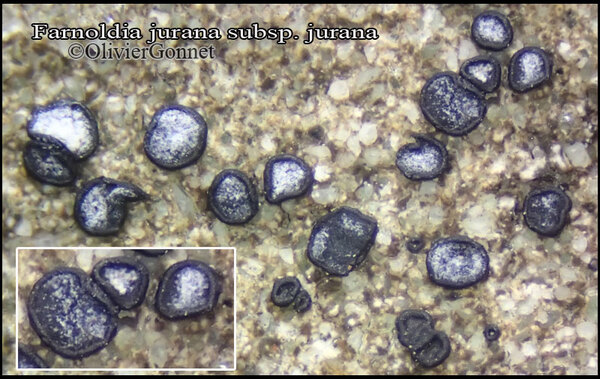
Courtesy Danièle et Olivier Gonnet - Source: https://www.afl-lichenologie.fr/Photos_AFL/Photos_AFL_F/Texte_F_1/Farnoldia_jurana_jurana.htm
France, Flaines, les grandes platières - Haute-Savoie
14/9/2015
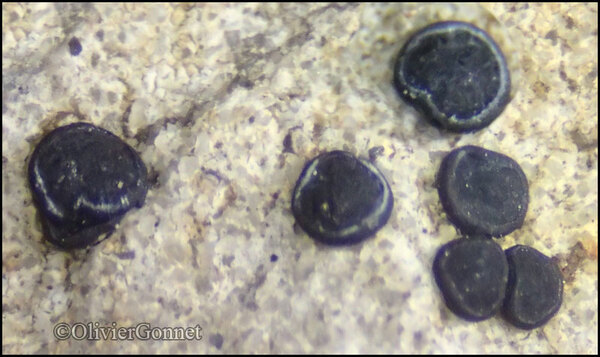
Courtesy Danièle et Olivier Gonnet - Source: https://www.afl-lichenologie.fr/Photos_AFL/Photos_AFL_F/Texte_F_1/Farnoldia_jurana_jurana.htm
France, Flaines, les grandes platières - Haute-Savoie
14/9/2015
Growth form: Crustose endolithic
Substrata: rocks
Photobiont: green algae other than Trentepohlia
Reproductive strategy: mainly sexual
Commonnes-rarity: (info)
Alpine belt: very common
Subalpine belt: extremely common
Montane belt: rather rare
Dry submediterranean belt: absent
Humid submediterranean belt: absent
Padanian area: absent
pH of the substrata:
| 1 | 2 | 3 | 4 | 5 |
Solar irradiation:
| 1 | 2 | 3 | 4 | 5 |
Aridity:
| 1 | 2 | 3 | 4 | 5 |
Eutrophication:
| 1 | 2 | 3 | 4 | 5 |
Poleotolerance:
| 0 | 1 | 2 | 3 |
Altitudinal distribution:
| 1 | 2 | 3 | 4 | 5 | 6 |
Rarity
absent
extremely rare
very rare
rare
rather rare
rather common
common
very common
extremely common
Loading data...
Occurrence data
Predictive map
 Current prediction (1981-2010)
Current prediction (1981-2010) Future prediction (2071-2100) SSP 1-2.6
Future prediction (2071-2100) SSP 1-2.6 Future prediction (2071-2100) SSP 5-8.5
Future prediction (2071-2100) SSP 5-8.5Predictive maps according to Francesconi et al. 2025

P.L. Nimis; Owner: Department of Life Sciences, University of Trieste
Herbarium: TSB (10641)
2001/11/24

P.L. Nimis; Owner: Department of Life Sciences, University of Trieste
Italy, Friuli Venezia Giulia, Udine, Passo del Pura, Ampezzo Carnico, 1400 m
09.09.2016

P.L. Nimis; Owner: Department of Life Sciences, University of Trieste
Italy, Friuli Venezia Giulia, Udine, Passo del Pura, Ampezzo Carnico, 1400 m
09.09.2016

P.L. Nimis; Owner: Department of Life Sciences, University of Trieste
Italy, Friuli Venezia Giulia, Udine, Ampezzo Carnico, 650 m
09.09.2016

Courtesy Danièle et Olivier Gonnet - Source: https://www.afl-lichenologie.fr/Photos_AFL/Photos_AFL_F/Texte_F_1/Farnoldia_jurana_jurana.htm
France, Flaines, les grandes platières - Haute-Savoie
14/9/2015



